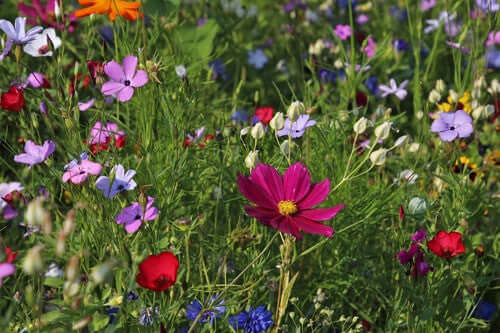
Rewild - Go natural
Share
Rewilding is the new buzzword on everyone’s lips, but what does it mean? It's a choice about how we decide to manage our land.
For example, when we take a step back and allow nature to take over in the garden we are encouraging insects and wild plants to flourish, which is restoring and protecting nature. If, however, we decided to lay concrete paving slabs over the same space the outcome for nature - in that given space - would be different. It turns out rewilding (at a domestic level) is something that we can all embrace, and it's simple to do.
The first thing to do is to change your mindset and value overtly ‘tidy’ gardens for what they are as far as wildlife is concerned – unwelcoming, desolate and stripped of nature. But it doesn’t have to be that way.
We're often far too worried about weeds, moss, slugs and greenfly. We've been saying it for years; however, let's say it again - the ideal wildlife garden would be free from weed killers, slug pellets, pesticides and fertilisers as these are killing the insects which life depends on. We understand it's a leap of faith to allow nature to step in and take its course - for birds to pick off greenfly and ladybirds to do the same.

If you are lucky enough to have a garden, then a front garden may be taken over with tarmac, shingles, or concrete to house a car. But there is still room for nature as you can plant a native hedge such as Hawthorn or Hazel. Or just an insect-friendly flower planted in a pot such as English Lavender or Buddleia - bees, we know, love lavender. A creeping native ivy up the side of your house would be an ideal source of food and shelter for insects and birds - especially Robins.
Just as the water supports life on earth, the best thing to add to a small space is water. If you have a large garden, a big pond is great but a tiny garden could have something as simple as a washing up bowl to attract newts, pond snails and damselflies. Even a dustbin lid turned upside down will do the trick.

Do not mow (too low) or weed killer your lawn, let it grow naturally and it could be full of species of grass which will eventually flower and welcome bees. If you'd like to send a message to the neighbours that you're rewilding rather than ignoring the lawn as - let's face it - we don't necessarily wish to live in a jungle by autumn, do we? - how about mowing a path through the grass and creating a meadow?
We know that gardeners find it hard to relax, but try letting dandelions flower and then seed. Allow poppies to flower between crops, and experiment by planting native wildflower mixes. Rewilding is as much about mindset as what you do/don't set (what you plant) in the garden - it's about accepting what's best for nature might mean a compromise for you, but you'll get to enjoy nature's natural delights from the comfort of your own home.
Even if you only have a window box it could be crammed full of wildflowers and a garden or house wall could house a bird box - but only if it’s not south facing. And don’t forget, bug hotels can be placed just about anywhere in a garden.

So the idea is to encourage wildness all around us. Our local North East Lincolnshire Council has this year for the first time, spread wild seeds along our roadside verges and public spaces. What's taken them so long? Better late than never.
We would love to know how you are improving nature in your garden.
Good luck!
Written by Angela

